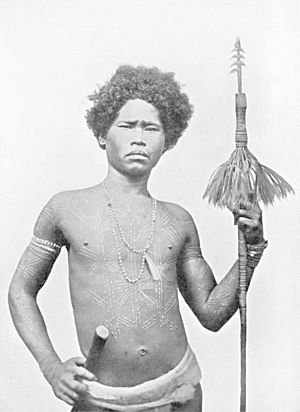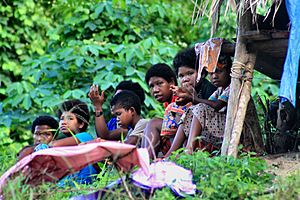Negrito facts for kids

A Luzon Negrito with spear
|
|
| Regions with significant populations | |
|---|---|
| Isolated geographic regions in India and Maritime Southeast Asia | |
| Languages | |
| Andamanese languages, Aslian languages, Philippine Negrito languages | |
| Religion | |
| Animism, folk religion, Christianity |
The term Negrito refers to several different groups of people. They live in isolated parts of Southeast Asia and the Andaman Islands. These groups are known for their relatively short height and dark skin.
Some of the groups called Negrito include the Andamanese peoples. These are the Great Andamanese, Onge, Jarawa, and Sentinelese. They live in the Andaman Islands. Other groups are the Semang peoples (like the Batek people) in Peninsular Malaysia. The Maniq people live in Southern Thailand.
In the Philippines, groups like the Aeta of Luzon Island are also called Negrito. This includes the Ati and Tumandok of Panay Island. The Agta of Sierra Madre and Mamanwa of Mindanao Island are also part of this group. There are about 30 other recognized ethnic groups in the Philippines as well.
What Does "Negrito" Mean?
The word Negrito comes from Spanish. It is a small version of the word negro, which means "black." So, Negrito means "little black person."
Spanish missionaries first used this word in the Philippines in the 1500s. Later, other European travelers used it too. They used it for various groups in Southeast Asia who seemed to have short bodies and dark skin.
Historically, the word Negrito was also used for pygmy peoples from Central Africa. This was because people thought they looked similar. However, grouping different ethnic groups just by how they look is not always accurate. Many people now question if this is the right way to describe them.
How Negrito People Live
Most groups called "Negrito" traditionally lived as hunter-gatherers. This means they found their food by hunting animals and gathering plants. Some groups also practiced simple agriculture, like harvesting plants.
Today, many Negrito people have joined the larger populations of their home countries. However, they often face challenges like unfair treatment and poverty. These problems can come from their social position or from their traditional hunter-gatherer ways of life.
Where Negrito People Came From
For a long time, people thought all Negrito groups were closely related. This was because they looked similar. But new studies of their genes tell a different story.
These studies show that Negrito groups are actually separate. They all came from the same ancient group of people in East Asia. This ancient group also led to modern East Asian peoples and Oceanian peoples. So, while they share a common distant ancestor, the Negrito groups are not all the same genetically.
Negrito people were the first inhabitants of Southeast Asia. Later, other groups speaking Austroasiatic and Austronesian languages moved into the area. These new groups came from southern East Asia during the Neolithic period (New Stone Age). Many Negrito people were absorbed by these new populations. The remaining Negrito groups now live as minorities in isolated areas.
Scientists have also found something interesting about their physical traits. Things like their short height, wide nose, curly hair, and dark skin are not just from a shared ancestor. Instead, these traits developed over time to help them live in tropical rainforests. This is called convergent evolution. It means different groups can develop similar traits if they live in similar environments.
There is also evidence that a Negrito-like population might have lived in Taiwan a long time ago. This was before the Neolithic expansion. Old human bones from about 6,000 years ago look similar to Negrito people, especially the Aetas in northern Luzon. Also, old Chinese reports and stories from Taiwanese indigenous peoples talk about people with "dark skin, short-and-small body stature, frizzy hair, and occupation in forested mountains or remote caves."
See also
 In Spanish: Negrito para niños
In Spanish: Negrito para niños



